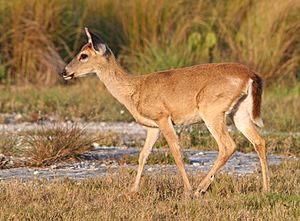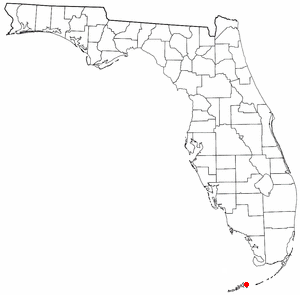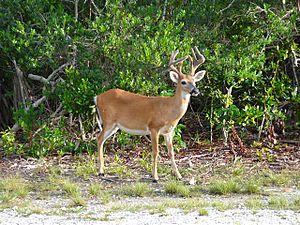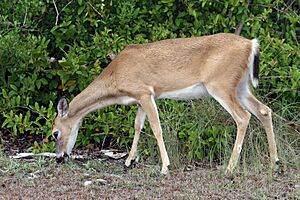Key deer facts for kids
The
Quick facts for kids Key deer |
|
|---|---|
 |
|
| A female on Big Pine Key | |
| Conservation status | |
| Scientific classification |
|
| Kingdom: | Animalia |
| Phylum: | Chordata |
| Class: | Mammalia |
| Order: | Artiodactyla |
| Family: | Cervidae |
| Subfamily: | Capreolinae |
| Genus: | Odocoileus |
| Species: | |
| Subspecies: |
O. v. clavium
|
| Trinomial name | |
| Odocoileus virginianus clavium Barbour & G. M. Allen, 1922
|
|
 |
|
| Key Deer range | |
The Key deer is a special kind of white-tailed deer. It is an endangered animal. This means there are not many left. Key deer live only in the Florida Keys. They are the smallest deer in North America.
Contents
Key Deer: What They Look Like
Key deer are much smaller than other white-tailed deer. Adult male Key deer are called bucks. They usually weigh about 25 to 34 kilograms (55-75 pounds). They stand about 76 centimeters (30 inches) tall at the shoulder.
Adult female Key deer are called does. They usually weigh between 20 and 29 kilograms (44-64 pounds). They are about 66 centimeters (26 inches) tall at the shoulders.
These deer are reddish-brown to grey-brown in color. Male deer grow Antlers. They shed their antlers between February and March. New antlers grow back by June. When antlers are growing, they have a soft, white coating called velvet.
Key Deer Behavior
Key deer are good swimmers. They can easily swim between different islands. They live very close to people. Because of this, they are not as afraid of humans as other deer. This is called island tameness.
You might see Key deer in people's yards. They also walk along roadsides. This is where they find plants and flowers to eat. Sometimes, deer get hit by cars. This often happens at night when it's harder to see them. You can often spot them around sunrise and sunset.
Key Deer Reproduction and Life Cycle
Key deer can have babies all year long. But most babies are born between October and December. Male deer will protect a female from other males during this time.
Male deer can live up to 9 years. Female deer usually live up to 7 years. Adult females often stay in loose groups with their daughters and granddaughters. Males usually stay together only when it's not breeding season.
Where Key Deer Live
Key deer used to live on all the lower Florida Keys. They lived wherever there was standing water. Now, their home is smaller. It stretches from Sugarloaf Key to Bahia Honda Key.
During the wet season, water is everywhere. Key deer use all the islands then. When it's dry, they go to islands with fresh water all year. By 2019, most Key deer lived on Big Pine Key.
Key deer live in many different places. These include pine forests, hardwood forests, mangrove swamps, and freshwater wetlands.
What Key Deer Eat
Key deer eat over 150 types of plants. But mangroves are very important to their diet. They eat red, white, and black mangroves. They also eat silver palm fruit and thatch palm berries.
Pine rockland areas are also important. They are often the only place to find fresh drinking water. Key deer can drink water that is a little bit brackish. People building homes can destroy deer habitat. This makes deer eat ornamental plants from gardens. This can lead to more problems between deer and humans.
Key Deer History and Protection
Key deer are a type of white-tailed deer. They came to the Florida Keys from the mainland. This happened during the Wisconsin glaciation, when a land bridge connected the areas. The first time Key deer were written about was in the 1550s. This was by a Spanish sailor named Hernando de Escalante Fontaneda.


Why Key Deer Are Endangered
People used to hunt Key deer for food. This included native tribes, sailors, and early settlers. Hunting them became illegal in 1939. But many deer were still hunted illegally. Their homes were also destroyed. By the 1950s, there were almost no Key deer left.
The National Key Deer Refuge was created in 1957. This is a special protected area. It is managed by the Wildlife Service.
Today, there are about 700 to 800 Key deer. This puts them on the endangered species list. Cars hitting deer on US 1 is a big problem. This road goes through the deer's small home. About 125 to 150 deer are killed by cars each year. This is 70% of all deer deaths.
People building more homes also hurts the deer. Their habitat is broken up and destroyed. People feeding deer is also bad. It makes the deer rely on human food. Fences also stop deer from moving around.
However, the number of Key deer has grown since 1955. Back then, there were only about 25 deer. The population seems stable now. But people are still moving into their habitat. Also, deer don't have many babies. This means their future is still uncertain.
In 2019, the USFWS suggested the Key deer might be taken off the endangered list. This was because their numbers had recovered. They are still listed, but a plan was updated in 2022. It explains when they could be delisted.
Rising sea levels are a new threat. This is due to climate change. It threatens the deer's remaining home. Some experts think Key deer might need help moving to new places. This could be their only way to survive.
Screw Worm Infestation
In 2016, a screw worm infestation happened. This was the first time in the U.S. since 1982. Screw worms are fly larvae. They get into an animal's open wound. Then they eat the animal's flesh. This can lead to a terrible death.
To fight this, scientists released sterile male flies. Female screw worms only mate once. So, if they mate with a sterile male, they won't lay fertile eggs. Other actions were taken too. Deer were given medicine. Healthy deer areas were fenced off. Some deer were tracked with radio collars.
The screw worm problem was gone by April 2017. But it killed 135 deer. This was about one-eighth of the whole herd.
Key Deer Conservation Efforts
The National Key Deer Refuge helps protect the deer. It covers about 8,500 acres (34 square kilometers). This includes Big Pine Key, No Name Key, and other small islands. Not all this land is public. About 5,000 acres (20 square kilometers) are still privately owned. These areas could be developed. About 1,000 acres (4 square kilometers) of this private land are on Big Pine Key and No Name Key. These are central areas for the deer.
In 2006, a habitat conservation plan was started. It limits building in important deer areas. It also helps buy more land for deer. This plan lasts for 15 years. But after that, much of the private land could still be developed. So, the deer's long-term future is still not certain.
Part of U.S. Route 1 was raised in 2003. This allows deer to walk safely under the road. It was hoped this would stop deer from being hit by cars. But the number of deer deaths from cars has not gone down.
The National Key Deer Refuge asks people not to feed the deer. Feeding them makes them used to humans and cars. This makes them more likely to be hit and killed. Also, being around people too much can make them sick. They can also be attacked by dogs. Or they can get tangled in human trash. All these things can hurt or kill them.
Images for kids
-
A male Key Deer on No Name Key in the lower Keys
-
A female Key deer on Big Pine Key









